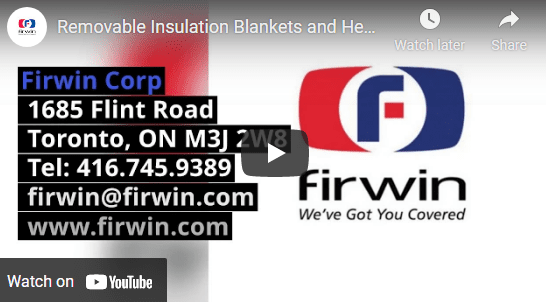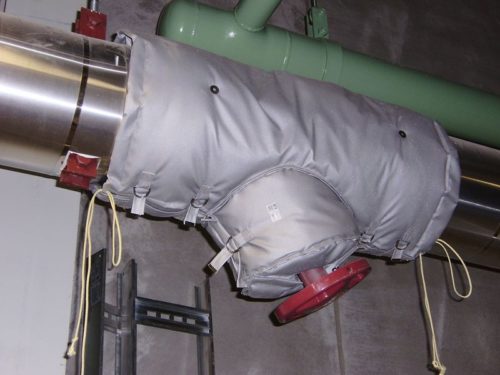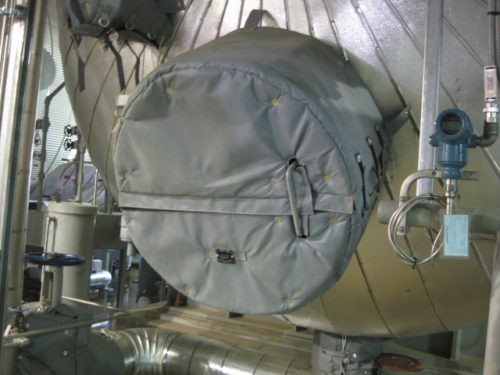Guide to Heat Tracing
Comments Off on Guide to Heat TracingTemperature regulation poses a challenge for many industrial piping processes. Even in warmer climates, heat loss can prevent pipes from remaining at the optimal temperature for their operations and contents, which threatens productivity and product quality, respectively.
Heat tracing, also known as trace heating, offers a solution to controlling pipe temperatures. The system involves running an electric heating element along the length of a pipe, often coupled with insulation, to facilitate even heating. The combination of thermal insulation with an active heating element provides a finer level of temperature control for pipes and vessels that is critical to many industries.
Why Use Heat Tracing?
Heat tracing is a highly versatile method of maintaining pipe or vessel temperatures. For some applications, it is used to prevent freezing during the winter, which is a significant threat to productivity. Even in applications where freezing is not a primary concern, heat tracing is one of the more efficient ways to ensure that pipes and vessels remain at the proper operating or processing temperature.
How Does Insulation Complement Heat Tracing?
To maximize the benefits of heat tracing, many installations also incorporate insulation. The layer of insulation bundles the heat tracing element and pipes together, helping maintain the interior temperature, reduce thermal loss, and maximize energy efficiency.
Applications of Heat Tracing
Applications for heat tracing commonly center around the oil and gas industries. Production, processing, and storage equipment in these industries generally require the maintenance of specific operating temperatures for optimal performance and productivity. For example, high temperatures are necessary to bring oil or gas to the surface during extraction. Some of the other functions of heat tracing in the oil and gas industries include maintenance of set temperatures during refining and storing processes and winterizing processing facilities in colder climates.
Additional industries where heat tracing is employed, include:
- Chemical production and processing
- Food processing
- Mining
- Pharmaceuticals
- Power generation
- Storage
- Water and waste processing
In these industries, heat tracing represents a cost-effective and energy-efficient management solution for applications like:
- Winterizing or freeze protecting pipes, tanks, and storage vessels
- Maintaining the temperature of storage tanks and hot water distribution pipes
- Integrating underfloor, roof, or gutter heating
- Heating walkways, roads, and other passenger and vehicle access areas to minimize snow and ice buildup
Heat Tracing Solutions From Firwin
An effective heat tracing setup requires high-quality components, including insulation, which largely influences how efficiently the system maintains and manages heat. At Firwin, we provide a full range of high-performance insulation for use with heat tracing.
Our durable insulation blankets—also referred to as insulation covers or jackets—are our flagship product. Available in a wide range of shapes, sizes, and configurations, all of our blankets are crafted from multi-layered performance materials and feature secure fastening systems to ensure a snug fit. No matter what component you’re seeking to protect, we offer a standard or customized insulation solution that can reduce the amount of heat loss in your system, maximizing the efficiency of your heat tracing.
Our extensive inventory of insulation blankets includes:
Valve Covers
Exposure to extreme temperatures and chemicals reduces the active service life of upstream equipment. Our tight-sealing valve covers fit over important junctions, keeping them safe from temperature fluctuations and other damaging environmental factors.
Flange Covers
Uncovered flanges can lead to heat loss at multiple points of a piping system. To prevent this, our removable insulation blankets are custom-designed to fit over all types and sizes of flanges.
Vessel and Manway Covers
In addition to maximizing efficiency, maintaining safety is another key concern regarding pipe tracing. In certain situations, vessels and manways can become somewhat hot, which can pose a risk to operators, service technicians, and passers-by. To prevent burns, our vessel and manway covers both trap heat and prevent direct contact with hot surface metal.
Instrumental Panel Covers
Complex and sensitive instrumentation also requires protection. Our removable insulation blankets provide excellent heat retention to the equipment as needed while allowing for ease of removal and reapplication.
Contact Firwin for Heat Trace Insulation Solutions
Heat tracing allows for efficient and cost-effective thermal regulation. The addition of insulation further increases its advantages. At Firwin, we carry high-quality insulation solutions for a wide range of industrial applications.
To learn more about our product offerings, contact us or request a quote today.
Introduction to Engine Component Insulation
Comments Off on Introduction to Engine Component Insulation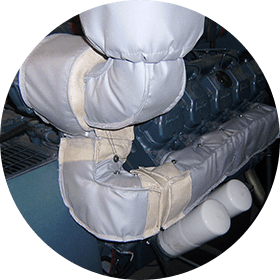
Engines play a vital role in a wide range of industrial applications. However, they also introduce a variety of hazards and risks to the work environment if the proper precautions are not implemented. For example, they can generate a significant amount of heat, which can negatively impact nearby equipment performance and integrity, and employee health and safety in the absence of a proper insulation solution. Insulation is key to protecting nearby employees and equipment while optimizing engine performance.
The Importance of Engine Component Insulation
If an engine does not have proper insulation, the heat it produces during use can lead to a significant rise in temperatures. Elevated temperatures can cause a number of problems for equipment and employees, such as:
- Increased employee discomfort. The heat generated by engines can raise ambient temperatures within the work environment to uncomfortable levels, which makes it difficult—if not impossible—for workers to complete their tasks safely. Insulation keeps heat contained within the engine or exhaust so it will not influence conditions in the surrounding area.
- Higher risk of employee injury/illness. Increased temperatures inside and outside the engine can also lead to employee injury or illness; for example, hot exterior surfaces can cause severe burns, while hot ambient temperatures can trigger heat exhaustion. Engine insulation protects employees from exposure to overly hot surfaces and temperatures.
- Greater chance of equipment damage. High engine temperatures can cause overheating in some systems. Additionally, they put any nearby thermally sensitive components (e.g., hoses and wires) at a higher risk of suffering thermal damage. Insulation shields components and equipment around the engine from potentially damaging heat.
- Decreased equipment performance. The performance of an engine is significantly affected by its ability to achieve and maintain proper internal temperatures. While high heat is detrimental to nearby components, systems, and people, it is critical to efficient operation. Insulation enables an engine to keep the heat it generates contained inside of it and its exhaust system so it can operate at optimal capacity. As a result, it helps reduce energy usage and emission levels.
Engine Component Insulation Solutions at Firwin
Firwin is an industry-leading supplier of insulation solutions. After nearly 40 years in the industry, we’ve garnered the knowledge and skills needed to create insulation products for a range of industrial applications. Our engine component insulation offerings include:
Removable Insulation Blankets
Our flagship product, removable insulation blankets are typically composed of the following 3 layers: an inner steel mesh layer, a middle insulation medium layer, and an outer silicone-coated fiberglass layer. Fastened in place with stainless steel lacing wire, they are perfect for engine components that require regular maintenance since they can be easily removed and replaced as needed. Additionally, they can be customized for fit and application-specific characteristics, such as alternative materials and fastening systems.
MineWrap™ Removable Blankets
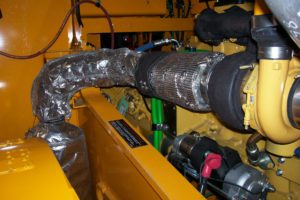
Our MineWrap insulation blankets are engineered to meet the specific needs of the underground mining industry. The flagship MineWrap Mark II has a flame-resistant foil inner liner lined with stainless steel mesh, which protects it from oil and hydraulic fluid intrusion and, consequently, eliminates the risk of fire. The MineWrap Mark III has a reinforced stainless steel foil exterior covered by a layer of stainless steel mesh, which makes it better suited for more demanding mining applications.
Permanent Hard Coat Composite Insulation
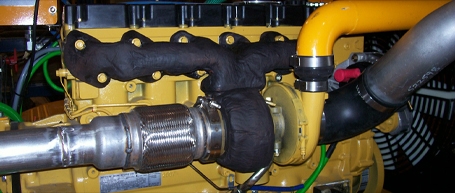
Our hard coat composite insulation coatings are an ideal insulation option for components that do not need regular repair and maintenance. After the composite coating is thinly applied to the target material, it forms a permanent high temperature insulation layer, that also protects the insulation material from combustion in the event of an engine leak or malfunction. It is rated for temperatures up to 900° F.
Stainless Steel Foil Insulation
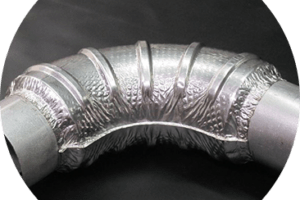 Our metal foil insulation (MFI) is another permanent insulation option for exhaust components (e.g., tubes, piping, and elbows). The insulation material is encapsulated by an outer foil layer that is permanently welded to the engine component, which results in a durable, leak-free, and highly customizable solution.
Our metal foil insulation (MFI) is another permanent insulation option for exhaust components (e.g., tubes, piping, and elbows). The insulation material is encapsulated by an outer foil layer that is permanently welded to the engine component, which results in a durable, leak-free, and highly customizable solution.
Contact Firwin for Engine Component Insulation Needs
Firwin’s highly customizable range of engine component insulation solutions makes it easy to prevent even the most powerful engines from harming your employees and equipment. Whether you need a removable or permanent product, we can help you protect your people, products, and processes. To learn more about our engine component insulation solutions and how they can benefit you, contact us today.

